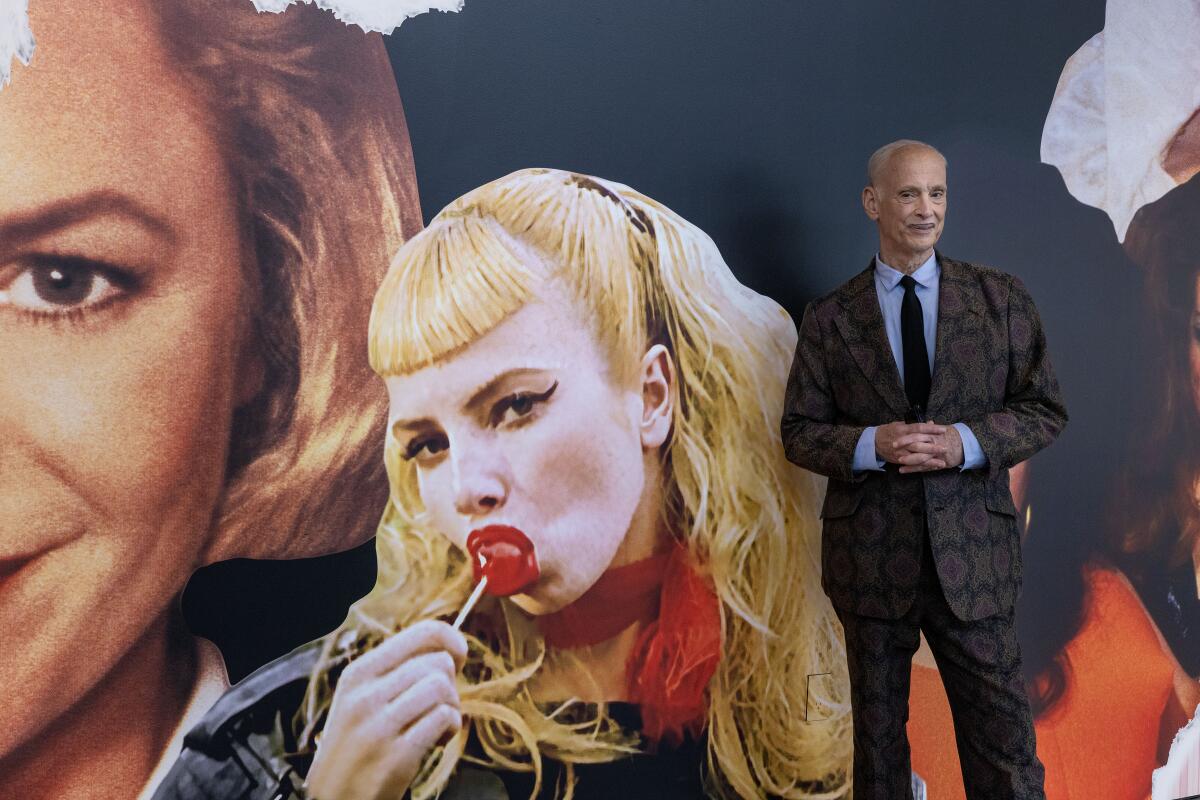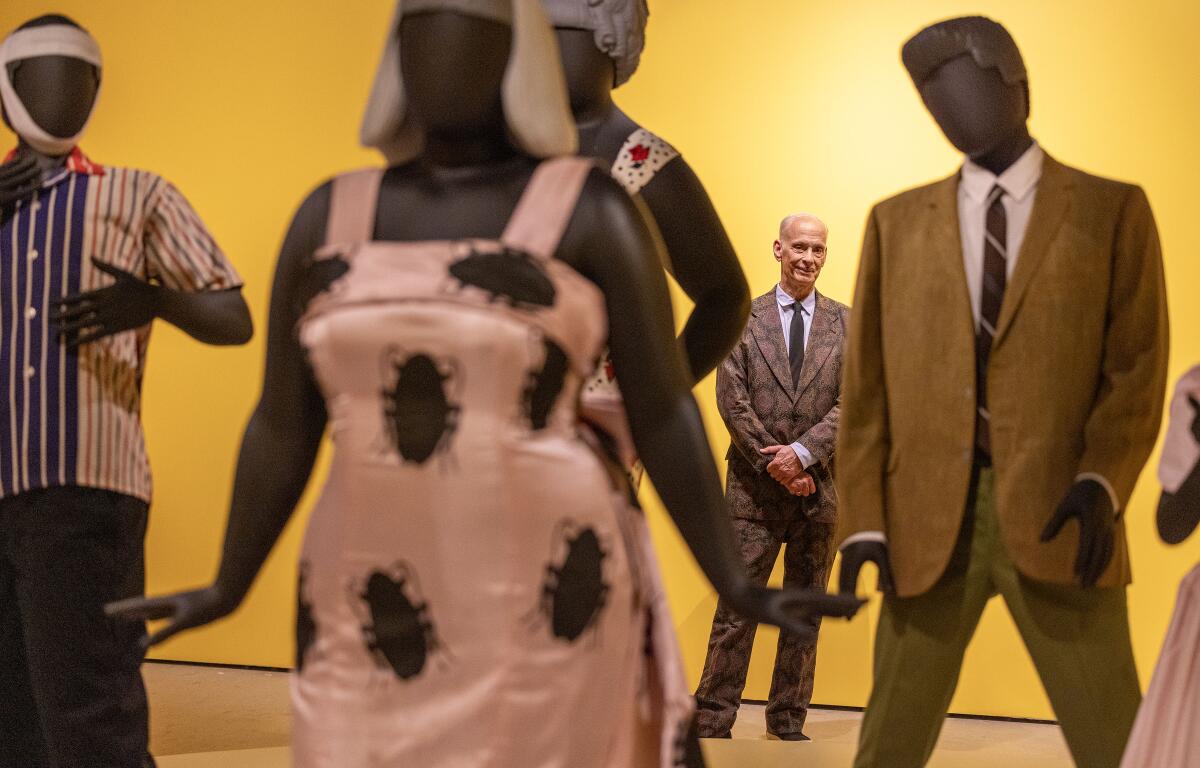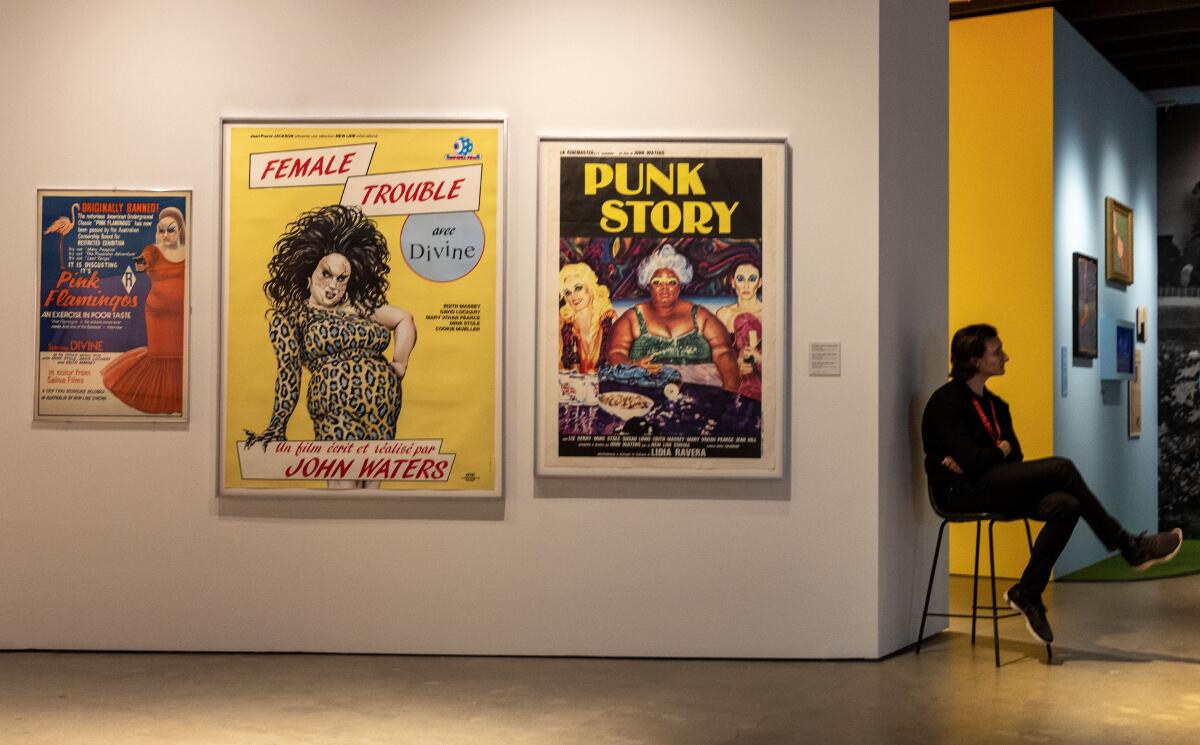John Waters gets celebrated in a fancy museum? Stranger things have happened

- Share via
With its latest exhibit, “John Waters: Pope of Trash,” the Academy Museum of Motion Pictures has paradoxically found a way to revere the irreverent.
The show, which opens to the public on Sunday and runs through August 2024, embodies the equally self-serious and campy sensibility that characterizes the Baltimore-born writer and director of “Hairspray” and “Multiple Maniacs.”
Taking his playful moniker in earnest, visitors are greeted with a space that welcomes you to sit at the altar of Waters — literally. A portrait of the thin-mustached director as a saintly figure sits alongside stained glass recreations of some of his most famous collaborators, including Divine and David Lochary, in a chapel-like antechamber. Church pews face a screen that plays a quick-cut montage featuring some of the most iconic moments from Waters’ six-decade (and counting) career.
From the start, “John Waters: Pope of Trash” announces itself as a lovingly mounted celebration, one that does so with a wink. Before visitors exit, they’re ushered into the pink-hued “Filth Shop” adorned with a quote from Waters that sums up the tension at the heart of the exhibit: “I’m so respectable, I could puke.” For someone whose career was built on outlaws, outliers and outsiders, Waters is very much at home within the hallowed halls of the Academy Museum.
“Well, I’m used to strange things happening in my life by now that you never imagined would happen,” the director told The Times on Thursday morning, after strolling through his takeover of the fourth floor. Props, scripts, costumes and even a replica of the trailer from 1972’s “Pink Flamingos” serve as an immersive, chronological précis of Waters’ cinematic work.
He had no irony to dispense when faced with such a gracious tribute, even when he first got the call about the exhibition years ago.
“I was incredibly excited about it and only a little melancholy that Divine would have been so proud to be here today,” Waters said. “But I was just thrilled, absolutely.”

Waters’ muse Divine, the drag performer who was transfixing on screen whether playing a criminal vixen or a put-upon suburban mom, died in 1988. But she rightly remains the beating heart of this retrospective. Her visage (arched penciled eyebrows, a killer lip) and demeanor (an unmatched go-for-broke approach to performance) loom large over more than 400 works on display. Taken as a whole, they trace how a young boy who once orchestrated violent puppet shows and began making ridiculously outré 8mm films with his friends in the 1960s became a fixture of American pop culture thanks to his self-described “filthy” creations.
“We were like a terrorist cell against the tyranny of good taste,” Waters says about his early days working with his self-dubbed Dreamlanders, the ragtag group of artists who helped bring the director’s delightfully deranged visions to life. In his films, the world of polite society — of suburban picket fences and parochial worldviews — was ripe for skewering.
“I was raised in the tyranny of good taste and that’s thankful because you have to know the rules,” he says. “If you’re going to parody any genre of films, you have to know that genre. That’s why I never made a science-fiction movie, because I’m not a fan of that genre. And I always made fun of the rules of the outlaw world that I was lucky enough to hope to live in.”
To walk through “John Waters: Pope of Trash” is to appreciate those various parodies (of melodramas, as with 1981’s “Polyester,” or true-crime courtroom dramas, as in 1994’s “Serial Mom”) as works of art given enough room to exist as cinematic experiences while still brimming with outrageousness.

At 77, Waters knows how lucky he is to see this career-spanning retrospective during his lifetime. “Debbie Harry and I talked about this, because things are going great in her career right now,” he says. “I said, ‘Aren’t we just glad to have grown up to get to see this?’ And she agreed. It’s just amazing when so many other people from that circuit that we know aren’t.”
He gets a kick knowing the curators pored over objects that would have otherwise been forgotten (even by himself), and are now displayed for the enjoyment of diehard fans and Waters neophytes alike. “I like the little things, like Mink’s glasses from “Pink Flamingos,” enthuses Waters. “They were rotting in an old box and now they’re restored. I just think it’s great. And I think, then, of all the things that have happened in between.”
It has been a career of ups and downs, successes, scandals, spotty financing and everything in between.
“I always had a backup plan,” Waters remembers. “If I couldn’t make a movie I would write a book or do a spoken-word show. You always have to have a backup plan because nothing lasts. And I think I’m not mean — that’s the most important thing. I have made fun of myself first, from the very beginning.”
Don’t mistake his mood for wistfulness. “I do not have nostalgia,” Waters assures me. “I’m always working for the future. This is not my end, you know? I plan more. So I’m reasonably nostalgic, but not completely.”
For starters, he never wants to find himself undermining the fights of younger generations with a rosy-colored vision of his radical past.
“If you say we had more fun than they did, you’re dead wrong,” Waters says. “They’re shocking us now with this new sexual revolution. I don’t look back and think we had more fun. Youth’s job is to surprise me. And they’ve really done it.”

Surprise has long anchored his work, as has shock. The most talked-about scene of all his movies remains the one in “Pink Flamingos” in which Divine eats dog feces. (Sadly, it wasn’t faked.)
But shock, Waters always knew, wouldn’t be enough.
“It’s easy to shock,” he explains. “It’s not easy to startle and make laugh and change things. I learned at school the term shock value. You say something outrageous to get someone’s attention and have them listen. I knew it worked. But I never tried to top the shock of ‘Pink Flamingos’ once I won. And I did win. It’s easy to shock people. But that doesn’t mean it’s funny or witty or good.”
Shock needs to be a jumping off point, never the point itself. “Everybody can be disgusting — it has to be disgusting and funny,” he adds.
And Waters has been both. His filmography is riddled with a brazen attitude toward everything from fame and crime to racial segregation and sexual revolutions, anarchy and ennui. Sex, too. “Yet no one has masturbated to one of my films,” he jokes.
But his satires have infiltrated the lexicon of American popular culture precisely because their humor is rooted in a desire to subvert. The exhibit playfully follows suit. A peephole (designed to spy on other gallery attendees) sits next to more staidly staged props, like Waters’ WGA career achievement award or a pair of shoes worn by Edith Massey. There’s even an animation cel from the director’s famous 1997 episode of “The Simpsons.”
“The very fact that the Academy is giving me a show just shows how things change,” says Waters. “Everything that lasts causes trouble at first. I built a career on bad reviews. We got a great review in Variety for ‘Female Trouble’ that I remember just warmed my heart. But then I got mean ones. You tend to remember those.”
He’s long followed his mother’s advice on that front: Read the bad ones once, the good ones twice. And then put them away.
And away they’ve gone, into his archive at Wesleyan University, where many of the artifacts that make up “John Waters: Pope of Trash” are normally housed.
“And now they’ve ended up at a museum,” he adds, almost disbelievingly.
More to Read
Only good movies
Get the Indie Focus newsletter, Mark Olsen's weekly guide to the world of cinema.
You may occasionally receive promotional content from the Los Angeles Times.










